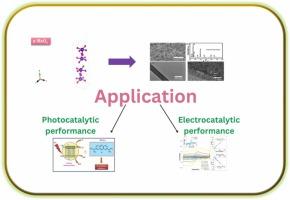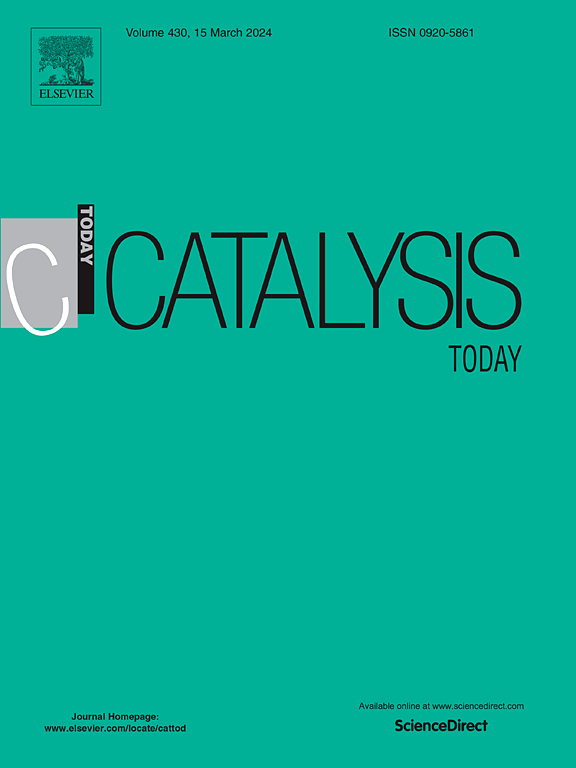An exploration of tailoring of hetero-nanostructures of α-MoO3 for efficient electrocatalytic and photocatalytic applications
IF 5.2
2区 化学
Q1 CHEMISTRY, APPLIED
引用次数: 0
Abstract
The primary focus of this review is the wide range of techniques available for generating α-MoO3 nanostructures. Some examples of these processes are hydrothermal method, solvothermal method, sol-gel methods, spray pyrolysis chemical, thermal evaporation, and own heterostructures. The various crystal and electronic structures of α-MoO3 offer a wealth of possibilities for the discovery of electrocatalysts that are suited for the creation of hydrogen through the splitting of water molecules. The orthorhombic form of α-MoO3 has showed potential electrocatalytic activity for the hydrogen evolution reaction (HER), while the polymorph has shown poor oxygen evolution reaction (OER) activity. This is the case even though both forms have been investigated. The as-prepared nanostructures were found to be effective photocatalysts for the breakdown of acridine orange when exposed to ultraviolet light. A high photocatalytic property was shown by the generated mixed morphology, which consisted of hexagonal nanoplatelets and nano bars, in order to breakdown the carcinogenic Acridine Orange dye. In addition, as a result of their 1-Dimensional and 2-Dimensional nanostructure feature, they are capable of being recycled with relative ease while maintaining their photocatalytic activity. In order to highlight the potential of α-MoO3 heterogeneous nanostructures for electrocatalytic and photocatalytic processes like CO2 reduction, hydrogen evolution, and pollutant degradation, this review will analyze and summarize recent developments in these areas. Also covered in this article are number of contemporary difficulties as well as prospective research directions based on α-MoO3 nanostructures.

为高效电催化和光催化应用定制 α-MoO3 异质纳米结构的探索
本综述的主要重点是可用于生成 α-MoO3 纳米结构的各种技术。这些工艺包括水热法、溶热法、溶胶-凝胶法、喷雾热解化学法、热蒸发法和自身异质结构法。α-MoO3 的各种晶体和电子结构为发现适合通过分裂水分子产生氢气的电催化剂提供了丰富的可能性。α-MoO3的正方体形式显示出潜在的氢进化反应(HER)电催化活性,而多晶体形式则显示出较差的氧进化反应(OER)活性。尽管对这两种形态都进行了研究,但情况仍然如此。研究发现,制备的纳米结构在紫外线照射下能有效分解吖啶橙。生成的混合形态(由六角形纳米片和纳米条组成)显示了很高的光催化性能,可以分解致癌的吖啶橙染料。此外,由于它们具有一维和二维纳米结构特征,因此在保持光催化活性的同时,还能比较容易地回收利用。为了突出α-MoO3异质纳米结构在电催化和光催化过程(如二氧化碳还原、氢进化和污染物降解)中的潜力,本综述将分析和总结这些领域的最新进展。本文还将介绍基于 α-MoO3 纳米结构的若干当代难题和前瞻性研究方向。
本文章由计算机程序翻译,如有差异,请以英文原文为准。
求助全文
约1分钟内获得全文
求助全文
来源期刊

Catalysis Today
化学-工程:化工
CiteScore
11.50
自引率
3.80%
发文量
573
审稿时长
2.9 months
期刊介绍:
Catalysis Today focuses on the rapid publication of original invited papers devoted to currently important topics in catalysis and related subjects. The journal only publishes special issues (Proposing a Catalysis Today Special Issue), each of which is supervised by Guest Editors who recruit individual papers and oversee the peer review process. Catalysis Today offers researchers in the field of catalysis in-depth overviews of topical issues.
Both fundamental and applied aspects of catalysis are covered. Subjects such as catalysis of immobilized organometallic and biocatalytic systems are welcome. Subjects related to catalysis such as experimental techniques, adsorption, process technology, synthesis, in situ characterization, computational, theoretical modeling, imaging and others are included if there is a clear relationship to catalysis.
 求助内容:
求助内容: 应助结果提醒方式:
应助结果提醒方式:


